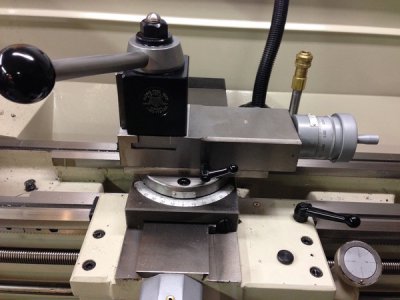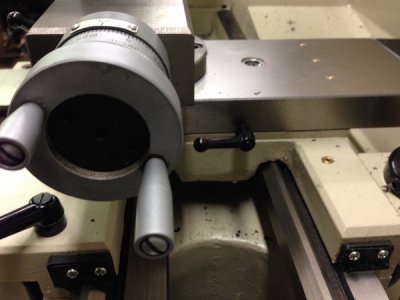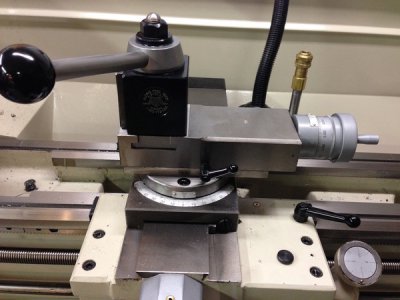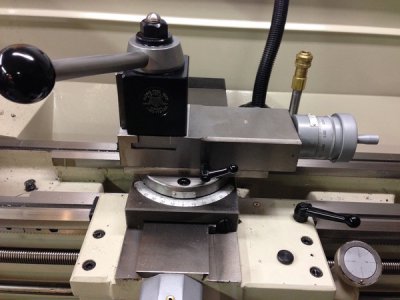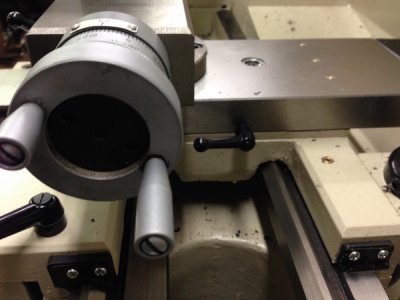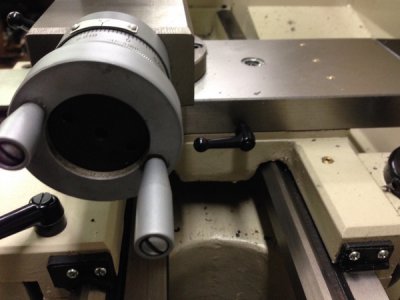- Joined
- Nov 23, 2014
- Messages
- 2,632
I got the OK from the boss to upgrade lathes. I settled on a Grizzly G0709 14 x 40 after considering a number of options. Won't bore everyone with all of the details, but I liked Grizzly's service rep, D1-5 spindle, brake, coolant and especially the universal quick change gear box. I ordered it on September 29, got the call from UPS Freight on October 2 to schedule a delivery.
Fortunately for me my brother-in-law has a truck dock and fork truck. Grizzly told me that because of the weight of the machine (1550 lbs.), power tailgate was not an options. I'm sure I've read other threads where mills have been delivered via Tommy-lift, but it wasn't an option for me.
Getting the crate off is a bit of a chore, lots of tabs to bend to lift off the top. Then lots of nails to pull to break down the crate. Unloading from my trailer was pretty painless because of my HF gantry crane. Wonderful piece of equipment by the way. If you have space for one, buy it! I used 830 lbs. rated ratchet straps on each corner which work well for balancing the load. It's hard to see in the photos, but I ran a loop of 1/4" cable also after the load was balanced for belt and suspenders.
Others have had shipping problems with their similar lathes, I did also. My tail stock under-bed clamp worked its way loose and fell in the chip pan. Fortunately the tail stock stayed on the top side of the bed though it did contact the carriage and chipped a little paint. The top knurled nut holding the back side head stock cover loosened up also. No damage here, nut was trapped under the flip-up sheet metal cover. The M5 set screw that retains the flip up cover to access the spindle spider was missing also. The High/Low range shift lever worked its way loose and was also in the bottom of the crate.
I broke the lathe in per Grizzly's instructions and changed the headstock and gear box fluid. I bought ISO 32 and ISO 68 oil from Tractor Supply for around $25 for 2 gallons. The drained fluid looked new; no chips, dirt or anything.
My other two lathes are a Delta/Rockwell 10 x 36 and a Clausing 5418 12 x 24. I owned an Atlas 12" some years ago which emcompasses my experience on turning tools. I'll add to this thread as I gain more experience on the Grizzly. Here are my first impressions (some are personal preferences based on my other lathe's set ups):
I really like the gear head speed shifting as compared to my Clausing's belt drive. Mine shifts very smoothly, need just a little turn of the chuck to get the gears to drop in. High / Low range is no problem. I have some issues shifting between the 4 speeds, probably operator error/experience more than anything. More than once I thought the lathe was in gear, hit the Jog button and spun the motor but not the spindle. I'm am getting better with experience.
The power switches on the headstock are inadequately mounted in my opinion. The 0.040" (give or take) thick aluminum screen printed panel cover is about 15" x 10" and is secured in the corners and on the sides. The switches mount to the thin aluminum and flex in/out too much for my liking. I pulled the panel and reinforced the switch area with a pieces of aluminum 1/8" thick x ~10" x 2". Much stiffer now.
I also don't like the micrometer dials on the cross feed and compound. They are large enough to easily read, but I'm used to loosening a lock screw, freely turning the wheel to position and locking it back down. This lathe uses a friction clutch of sorts to position the dials. According to the parts drawings there are two springs and balls under the dials to add some friction. You need to hold the handles rock steady as you turn the dials to zero. I'm concerned that the crank will move a bit as the dial is rotated regardless of how carefully I hold the crank. I'm likely adding a taper attachment to this lathe which gives me a new cross feed arrangement, will likely drill and tap a hole in dial to add a locking screw and lose the springs/balls. Maybe I'll get used to it over time.
I did some single point threading for an M8 x 1.25 bolt to replace the carriage locking bolt. It's a cap screw as designed. I made a 303 stainless screw/clamp arm for locking the carriage. No issue with the threads. Love being able to switch between most metric and english threads without fiddling with head stock end gears.
I had to adjust the tail stock to center up with the spindle. Others noted having problems with this but it didn't take me long at all. Same adjustment as my Clausing and Rockwell lathes; loosen one screw, tighten the other to offset the center. Mine is better than 0.0005" over 12" (for now).
I haven't checked the accuracy of the compound protractor yet, heard from others it's off. I did my M8 x 1.25 with the compound set to 60 deg. Thread came out fine. The protractor only covers 120 degrees of rotation, both my Clausing and Rockwell are graduated through a couple of clocking marks to a full 360.
One thing I don't like about the compound is you can't swing it a full 360. The crank on the compound will hit the light and coolant nozzle when swung 120 deg. from straight on. Chamfering will be done with the compound swung towards the chuck instead around to the back side of the bed.
QCTP lock lever is off by 90 degrees from I'm used to. I've seen a couple of youtube videos of other guys with the same thing so it's probably on most/all of them. The piston style post has the two typical dovetails that I'll call turning/facing and boring. The lock lever for facing is locked either at about 7 o'clock or 1 o'clock. 1 o'clock is over your work if you're turning something long. I'm used to the lever ending up at around 5 o'clock when locked. So why not use the lever at the 7 o'clock locking position? To unlock it you turn it to 8 o'clock which puts the lever just over the tool holder. Can't lift the tool holder off because it's under the lock lever. I fixed it by pulling the two plates that move in/out on the tool post and ground about 0.025" off the front/back. My lock lever now locks in place at 5 o'clock for both turning/facing and boring.
Really like having a back splash for keeping swarf off the floor. I'm going to lose the sheet metal spreader between the head stock and tail stock cabinets and replace it with a shelf/drawer unit. Not that I want to do a lot of deep knee bends to grab stuff from under the bed, it's just my personal preference. Seems like a good place to put the tool box, steady/follow rests and faceplate. I'm going to repurpose the spreader by turning it into a back splash on my Clausing lathe.
Longitudinal cranking is about 1/2 the travel per turn as my Clausing; 9/16" on the Grizzly, just over an inch on the Clausing. On the plus side the Grizzly longitudinal crank is graduated; easy to tell how much you're taking off when facing.
Overall I'm very happy at this point. I parted a 1 1/2" round of 303 stainless with a HSS cut off blade with no incidents. Not a hint of chatter.
I'll post updates as I get more experienced on the lathe.
Bruce
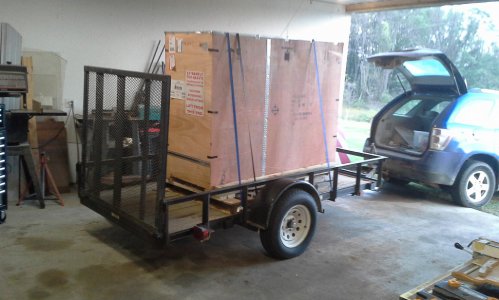
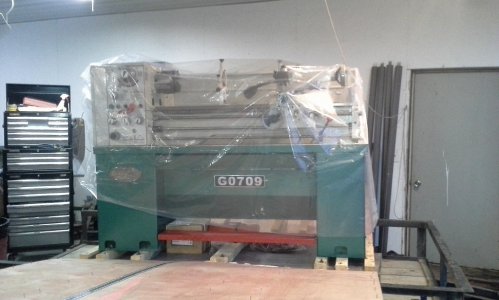
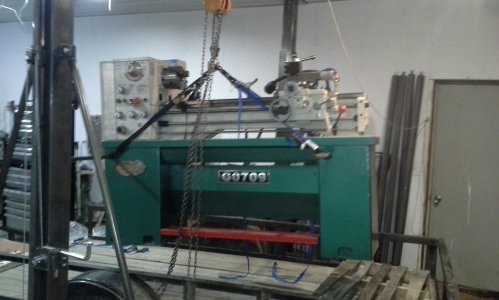
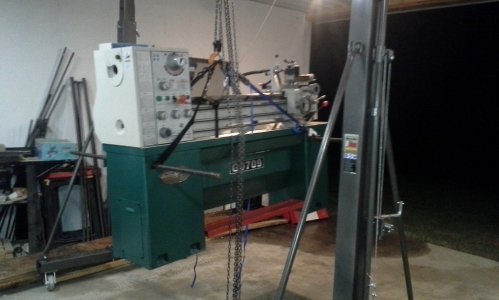
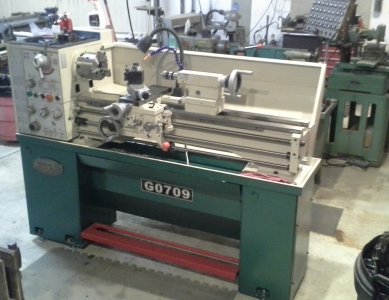
Fortunately for me my brother-in-law has a truck dock and fork truck. Grizzly told me that because of the weight of the machine (1550 lbs.), power tailgate was not an options. I'm sure I've read other threads where mills have been delivered via Tommy-lift, but it wasn't an option for me.
Getting the crate off is a bit of a chore, lots of tabs to bend to lift off the top. Then lots of nails to pull to break down the crate. Unloading from my trailer was pretty painless because of my HF gantry crane. Wonderful piece of equipment by the way. If you have space for one, buy it! I used 830 lbs. rated ratchet straps on each corner which work well for balancing the load. It's hard to see in the photos, but I ran a loop of 1/4" cable also after the load was balanced for belt and suspenders.
Others have had shipping problems with their similar lathes, I did also. My tail stock under-bed clamp worked its way loose and fell in the chip pan. Fortunately the tail stock stayed on the top side of the bed though it did contact the carriage and chipped a little paint. The top knurled nut holding the back side head stock cover loosened up also. No damage here, nut was trapped under the flip-up sheet metal cover. The M5 set screw that retains the flip up cover to access the spindle spider was missing also. The High/Low range shift lever worked its way loose and was also in the bottom of the crate.
I broke the lathe in per Grizzly's instructions and changed the headstock and gear box fluid. I bought ISO 32 and ISO 68 oil from Tractor Supply for around $25 for 2 gallons. The drained fluid looked new; no chips, dirt or anything.
My other two lathes are a Delta/Rockwell 10 x 36 and a Clausing 5418 12 x 24. I owned an Atlas 12" some years ago which emcompasses my experience on turning tools. I'll add to this thread as I gain more experience on the Grizzly. Here are my first impressions (some are personal preferences based on my other lathe's set ups):
I really like the gear head speed shifting as compared to my Clausing's belt drive. Mine shifts very smoothly, need just a little turn of the chuck to get the gears to drop in. High / Low range is no problem. I have some issues shifting between the 4 speeds, probably operator error/experience more than anything. More than once I thought the lathe was in gear, hit the Jog button and spun the motor but not the spindle. I'm am getting better with experience.
The power switches on the headstock are inadequately mounted in my opinion. The 0.040" (give or take) thick aluminum screen printed panel cover is about 15" x 10" and is secured in the corners and on the sides. The switches mount to the thin aluminum and flex in/out too much for my liking. I pulled the panel and reinforced the switch area with a pieces of aluminum 1/8" thick x ~10" x 2". Much stiffer now.
I also don't like the micrometer dials on the cross feed and compound. They are large enough to easily read, but I'm used to loosening a lock screw, freely turning the wheel to position and locking it back down. This lathe uses a friction clutch of sorts to position the dials. According to the parts drawings there are two springs and balls under the dials to add some friction. You need to hold the handles rock steady as you turn the dials to zero. I'm concerned that the crank will move a bit as the dial is rotated regardless of how carefully I hold the crank. I'm likely adding a taper attachment to this lathe which gives me a new cross feed arrangement, will likely drill and tap a hole in dial to add a locking screw and lose the springs/balls. Maybe I'll get used to it over time.
I did some single point threading for an M8 x 1.25 bolt to replace the carriage locking bolt. It's a cap screw as designed. I made a 303 stainless screw/clamp arm for locking the carriage. No issue with the threads. Love being able to switch between most metric and english threads without fiddling with head stock end gears.
I had to adjust the tail stock to center up with the spindle. Others noted having problems with this but it didn't take me long at all. Same adjustment as my Clausing and Rockwell lathes; loosen one screw, tighten the other to offset the center. Mine is better than 0.0005" over 12" (for now).
I haven't checked the accuracy of the compound protractor yet, heard from others it's off. I did my M8 x 1.25 with the compound set to 60 deg. Thread came out fine. The protractor only covers 120 degrees of rotation, both my Clausing and Rockwell are graduated through a couple of clocking marks to a full 360.
One thing I don't like about the compound is you can't swing it a full 360. The crank on the compound will hit the light and coolant nozzle when swung 120 deg. from straight on. Chamfering will be done with the compound swung towards the chuck instead around to the back side of the bed.
QCTP lock lever is off by 90 degrees from I'm used to. I've seen a couple of youtube videos of other guys with the same thing so it's probably on most/all of them. The piston style post has the two typical dovetails that I'll call turning/facing and boring. The lock lever for facing is locked either at about 7 o'clock or 1 o'clock. 1 o'clock is over your work if you're turning something long. I'm used to the lever ending up at around 5 o'clock when locked. So why not use the lever at the 7 o'clock locking position? To unlock it you turn it to 8 o'clock which puts the lever just over the tool holder. Can't lift the tool holder off because it's under the lock lever. I fixed it by pulling the two plates that move in/out on the tool post and ground about 0.025" off the front/back. My lock lever now locks in place at 5 o'clock for both turning/facing and boring.
Really like having a back splash for keeping swarf off the floor. I'm going to lose the sheet metal spreader between the head stock and tail stock cabinets and replace it with a shelf/drawer unit. Not that I want to do a lot of deep knee bends to grab stuff from under the bed, it's just my personal preference. Seems like a good place to put the tool box, steady/follow rests and faceplate. I'm going to repurpose the spreader by turning it into a back splash on my Clausing lathe.
Longitudinal cranking is about 1/2 the travel per turn as my Clausing; 9/16" on the Grizzly, just over an inch on the Clausing. On the plus side the Grizzly longitudinal crank is graduated; easy to tell how much you're taking off when facing.
Overall I'm very happy at this point. I parted a 1 1/2" round of 303 stainless with a HSS cut off blade with no incidents. Not a hint of chatter.
I'll post updates as I get more experienced on the lathe.
Bruce












